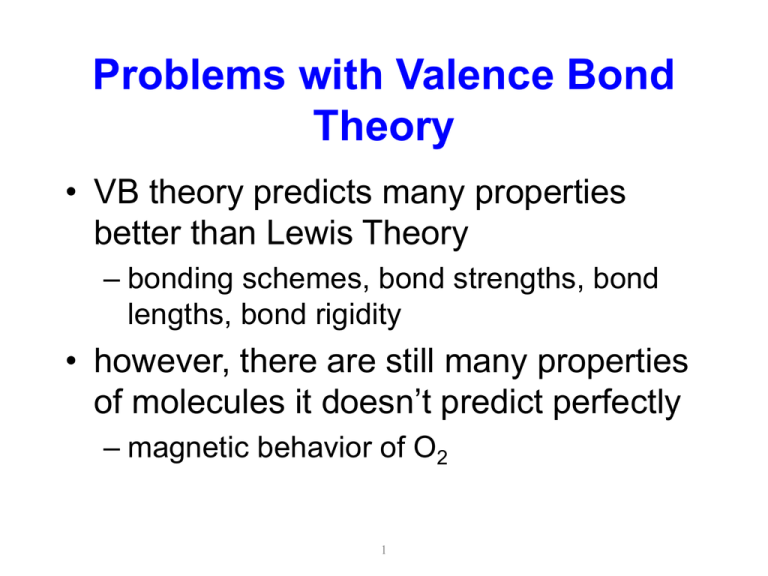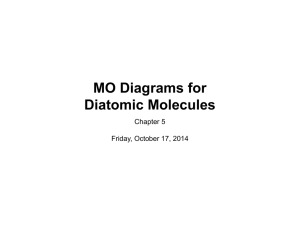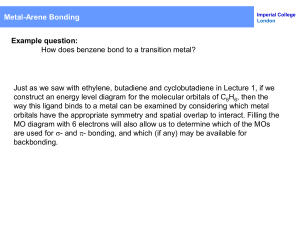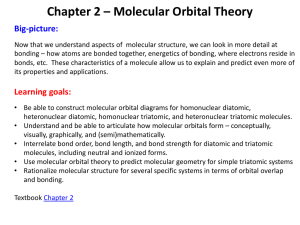Problems with Valence Bond Theory
advertisement

Problems with Valence Bond Theory • VB theory predicts many properties better than Lewis Theory – bonding schemes, bond strengths, bond lengths, bond rigidity • however, there are still many properties of molecules it doesn’t predict perfectly – magnetic behavior of O2 1 Aurora Borealis Chapter 9 | Slide 2 Chapter 9 | Slide 2 Valence Bond Theory • Valence Bond Model of covalent bonding is easy to visualize, but it does have some problems: – Incorrectly assumes that electrons are localized and so we have to use resonance to describe some molecules. – Does not do a good job of describing molecules containing unpaired electrons – Does not indicate bond energies 3 Valence Bond Theory • Valence Bond Model does not explain why O2 is attracted to a magnetic field while N2 is slightly repelled nor accounts for the emission of light by molecules in an aurora. • The need to explain the magnetic behavior seen for O2 led to the development of another bonding theory called the Molecular Orbital (MO) Theory. 4 Molecular Orbital Theory • in MO theory, we apply Schrödinger’s wave equation to the molecule to calculate a set of molecular orbitals – in practice, the equation solution is estimated – we start with good guesses from our experience as to what the orbital should look like – then test and tweak the estimate until the energy of the orbital is minimized • in this treatment, the electrons belong to the whole molecule – so the orbitals belong to the whole molecule – unlike VB Theory where the atomic orbitals still exist in the molecule 5 LCAO • the simplest guess starts with the atomic orbitals of the atoms adding together to make molecular orbitals – this is called the Linear Combination of Atomic Orbitals (LCAO) method – weighted sum • because the orbitals are wave functions, the waves can combine either constructively (additive) or destructively (subtractive) 6 Bonding in H2 9.2 Chapter 9 | Slide 7 Molecular Orbitals • when the wave functions combine constructively, the resulting molecular orbital has less energy than the original atomic orbitals – it is called a Bonding Molecular Orbital s, p – most of the electron density between the nuclei 8 Molecular Orbitals • when the wave functions combine destructively, the resulting molecular orbital has more energy than the original atomic orbitals – it is called a Antibonding Molecular Orbital s*, p* – most of the electron density outside the nuclei – nodes between nuclei 9 Molecular Orbital Model • Molecular electron configurations can be written similar to atomic electron configurations. • Each molecular orbital can hold 2 electrons with opposite spins. • Orbitals are conserved. Chapter 9 | Slide 10 Sigma Bonding and Antibonding Orbitals Chapter 9 | Slide 11 Molecular Orbital Theory • Electrons in bonding MOs are stabilizing – Lower energy than the atomic orbitals • Electrons in anti-bonding MOs are destabilizing – Higher in energy than atomic orbitals – Electron density located outside the internuclear axis – Electrons in anti-bonding orbitals cancel stability gained by electrons in bonding orbitals 12 Hydrogen Atomic Orbital Dihydrogen, H2 Molecular Orbitals Hydrogen Atomic Orbital s* 1s 1s s Since more electrons are in bonding orbitals than are in antibonding orbitals, net bonding interaction 13 Helium Atomic Orbital Dihelium, He2 Molecular Orbitals Helium Atomic Orbital s* 1s 1s s Since there are as many electrons in antibonding orbitals as in bonding orbitals, there is no net bonding interaction 14 MO and Properties • Bond Order = difference between number of electrons in bonding and antibonding orbitals – only need to consider valence electrons – may be a fraction (partial bond order) – higher bond order = stronger and shorter bonds – if bond order = 0, then bond is unstable compared to individual atoms - no bond will form. # Bond Elec. - # Antibond Elec. Bond Order 2 15 Lithium Atomic Orbitals Dilithium, Li2 Molecular Orbitals s* 2s Lithium Atomic Orbitals 2s s s* BO = ½(4-2) = 1 1s 1s s Since more electrons are in bonding orbitals than are in antibonding orbitals, net bonding interaction 16 Diatomic O2 • dioxygen is paramagnetic • paramagnetic material have unpaired electrons • neither Lewis Theory nor Valence Bond Theory predict this result • Paramagnetism – substance is attracted into the inducing magnetic field. • Diamagnetism – substance is repelled from the inducing magnetic fiel 17 Diatomic Oxygen, O2 • Dioxygen is attracted to a magnetic field! • Neither Lewis Theory nor Valence Bond Theory predict this result. • Paramagnetism – substance is attracted into the inducing magnetic field. - Unpaired electrons (O2) • Diamagnetism – substance is repelled from the inducing magnetic field. - Paired electrons (N2) 18 Magnetic Properties of Liquid Nitrogen and Oxygen Chapter 9 | Slide 19 Pi Bonding and Antibonding Orbitals Chapter 9 | Slide 20 p Atomic Orbitals and the Formation of Molecular Orbitals Molecular Orbital Diagram for B2 Molecular Orbital Diagram for O2 s and p Orbital Mixing No s-p mixing s-p mixing B2s = 14 eV vs B2p = 8.3 eV O2s = 32.3eV vs O2p = 15.9 eV s-p mixing No s-p mixing 1 electron volt (eV) = 1.60217646 × 10-19 joules Factors that Affect the Formation of Molecular Orbitals Symmetry • s and s • pz and pz (pz is along the bonding axis) • s and pz Energy • Orbitals must have similar energy in order to overlap Heteronuclear Diatomic Molecules • the more electronegative atom has lower energy orbitals • when the combining atomic orbitals are identical and equal energy, the weight of each atomic orbital in the molecular orbital are equal • when the combining atomic orbitals are different kinds and energies, the atomic orbital closest in energy to the molecular orbital contributes more to the molecular orbital – lower energy atomic orbitals contribute more to the bonding MO – higher energy atomic orbitals contribute more to the antibonding MO • nonbonding MOs remain localized on the atom donating its atomic orbitals 28 Molecular Orbital Diagram of Hydrogen Fluoride H1s = 13.6 eV 32.8 eV F2s = 46.4 eV F2p = 18.7 eV n.b. - nonbonding orbitals Molecular Orbital Diagram of Carbon Monoxide C2s = 19.5 eV O2s = 32.3 eV O2p = 15.9 eV Polyatomic Molecules • when many atoms are combined together, the atomic orbitals of all the atoms are combined to make a set of molecular orbitals which are delocalized over the entire molecule • gives results that better match real molecule properties than either Lewis or Valence Bond theories 31 Valence Bond Model of Ozone Molecular Orbital Model of Ozone Resonance Structures of Benzene Molecular Orbital Model of Benzene





